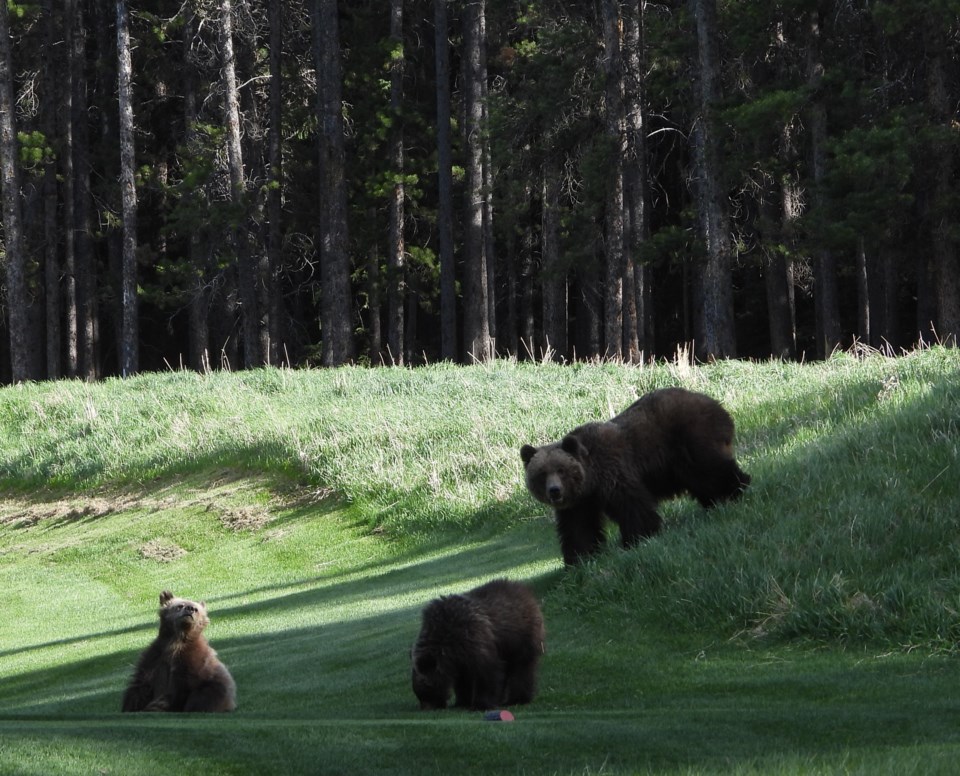BANFF – A well-known mama grizzly bear and one of her yearling cubs has been struck and killed by a train in Banff National Park.
The adult female, known as 130, was with her two yearlings on the Canadian Pacific Railway tracks at Mile 84.3 just west of the Banff townsite about 10 a.m.. on Thursday (June 24) when struck. One of the two cubs is alive and appears to be uninjured.
Parks Canada officials say wildlife experts, who raced to the scene when the report of the train strike came in to Banff dispatch, identified the bear as 130 based on a broken ear tag.
“The yearling that survived the incident appears to be uninjured and is moving through the area,” said David Dunbar, a spokesperson for Banff National Park.
“It is being monitored by Parks Canada staff. Precedent has shown that given its age and size, the orphaned yearling has a good chance of survival moving forward.”
There are no further details at this time on Parks Canada’s plans for this surviving young bear, whether it will be relocated to a quieter area of the park within its home range, or left alone.
On June, 3, Bear No. 130 and her cubs took down a newborn calf on the Banff Springs Golf Course, much to the surprise of a group of golfers on hole 2 of the Stanley Thompson.
“Some golfers had seen a calf run out onto the course and right behind it was one of the yearling cubs, and it nailed the calf and took it down right in front of them,” said Blair Fyten, a human-wildlife co-existence specialist with Banff National Park.
“A few seconds later, out of the bush comes mom and the other yearling, and mom grabs the calf, picks it up and heads back into the woods. Within minutes, they had pretty much eaten the calf and moved on.”
Bear No. 130, thought to be about 10 to 12 years old, emerged from the den in 2020 with three cubs in tow, but only two have been seen with her so far this spring.
In 2014, Bear 136, also known as Split Lip for his disfigured mouth, was the prime suspect in killing her previous litter of cubs.
Bear No. 130 did not hang around high-human use areas as a general rule, but it appears she was moving along on a narrow corridor on the train tracks foraging for food with her cubs.
Her home range does include the Bow Valley Parkway and the Fairhome bench, but she has been hanging around the Banff townsite this spring, including on Tunnel Mountain and the grassy greens of the Banff Springs Golf Course.
“She is a bear that hangs out a little bit around here, but more so the 1A and the Fairholme area,” Fyten said.
The premature death of bear 130 and one of her yearling cubs follows the death of bear No. 156 at the end of May in neighbouring Yoho National Park, who was struck by a vehicle on the Trans-Canada Highway near Field.
No. 156’s orphaned cubs, a male and a female, were relocated to a remote area of the backcountry within 156’s home range, which includes parts of Banff and Yoho national parks.
In Banff National Park, the death of No. 130 and one of her yearlings are the first confirmed grizzly bear mortality incidents on the railway in 2021.
Female bear 143, who had two cubs last year, was struck and killed on the train tracks between Caste Mountain and Lake Louise in September 2020. She spent most of her time in the backcountry of Banff and the adjacent Yoho and Kootenay national parks.
Grizzly bears are listed as threatened species in Alberta. Since 2000, at least 17 grizzly bears have been killed on the train tracks in Banff and Yoho national parks, which is considered a significant blow to Banff’s population of about 60 grizzlies.
Survival of female bears is considered critical to the population, given ongoing research has found that Banff’s bears reproducing more slowly than in other areas of North America because their food supply is limited in the harsh, mountain habitat.
Read more from RMOToday.com



